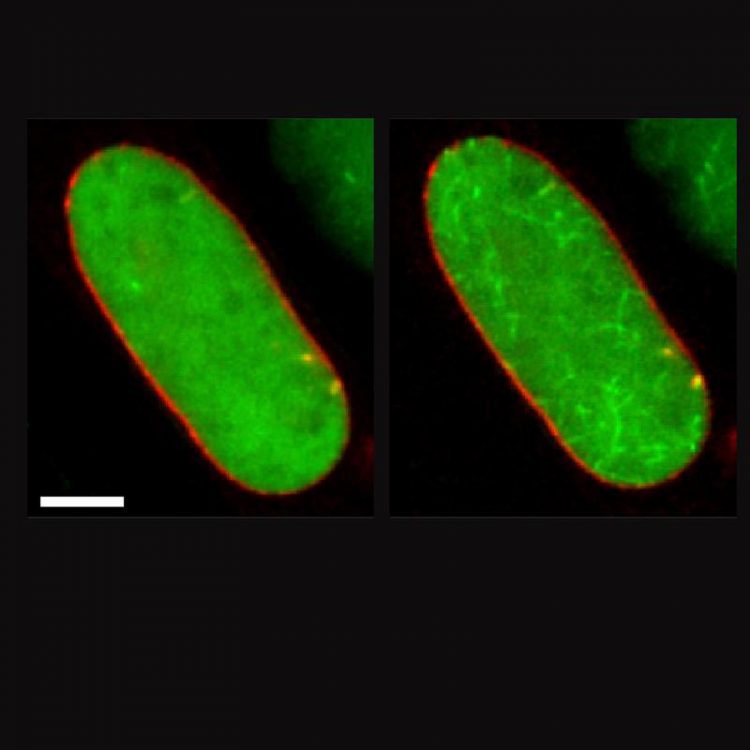Filaments that structure DNA

After the cell has been treated with a messenger substance (right), the green actin molecules in the red cell nucleus (left) form actin filaments that structure the genome. Image: Robert Grosse
They play a leading role not only in muscle cells. Actin filaments are one of the most abundant proteins in all mammalian cells. The filigree structures form an important part of the cytoskeleton and locomotor system.
Cell biologists at the University of Freiburg are now using cell cultures to show how receptor proteins in the plasma membrane of these cells transmit signals from the outside to actin molecules inside the nucleus, which then form threads.
In a new study, the team led by pharmacologist Professor Robert Grosse uses physiological messengers to control the assembly and disassembly of actin filaments in the cell nucleus and shows, which signaling molecules control the process. The results of their study have been published in the latest Nature Communications.
“It was previously unknown just how a hormone or agent induces the cell to begin filament formation in the intact cell nucleus,” Grosse says. Back in 2013, he discovered that actin threads were formed in the nucleus when he exposed cells to serum components. In the nucleus, actin usually occurs as a single protein.
It only forms filaments when a signal is given. Actin filaments resemble a double chain of beads and create possible anchor points or pathways for the structures in the cell nucleus. They give the DNA structure – for example, determining how densely packed the chromosomes in the form of chromatin are. This influences the readability of the genetic material. “What we have here is a generally valid mechanism that shows how external, physiological signals can control the cytoskeleton in the nucleus and reorganize the genome in a very short time,” Grosse explains.
Grosse is familiar with the signaling pathway that reaches into the nucleus, known as the G-protein-coupled receptor pathway. Agents, hormones, or signal transmitters bind these receptor types at the cell membrane, which is a target for a large number of clinical drugs. The receptor initiates a calcium release in the cell via a signaling cascade.
The team then shows that intracellular calcium causes filaments to be formed on the inner membrane of the cell nucleus. In the study, they used fluorescence microscopy and genetic engineering methods to show how actin filaments appeared in the nucleus after physiological messengers such as thrombin and LPA bound to G-protein-coupled receptors.
In the research project within the University of Freiburg excellence cluster CIBSS – Centre for Integrative Biological Signalling Studies, Grosse is now investigating the more exact processes in the cell nucleus. “My team in Freiburg wants to find out in detail how filament formation influences the readability of the genetic material and what role the inner cell nucleus membrane plays in this process.”
Study:
Wang, Y., Sherrard, A., Zhao, B. et al. GPCR-induced calcium transients trigger nuclear actin assembly for chromatin dynamics. Nat Commun 10, 5271 (2019) doi:10.1038/s41467-019-13322-y
Video:
The actin molecules (green) form filaments in the nucleus of mouse cells (red: nuclear membrane) as a reaction to physiological messengers outside the cell. Researchers at the University of Freiburg have now shown which signaling pathways are active here.
Video: Robert Grosse
www.pr.uni-freiburg.de/go/filamente
Contact:
Professor Dr. Robert Grosse
Professor of Experimental and Clinical Pharmacology and Toxicology
CIBSS – Centre for Integrative Biological Signalling Studies
Phone: 0761/203-5302
robert.grosse@pharmakol.uni-freiburg.de
https://www.pr.uni-freiburg.de/pm-en/press-releases-2019/filaments-that-structur…
Media Contact
All latest news from the category: Life Sciences and Chemistry
Articles and reports from the Life Sciences and chemistry area deal with applied and basic research into modern biology, chemistry and human medicine.
Valuable information can be found on a range of life sciences fields including bacteriology, biochemistry, bionics, bioinformatics, biophysics, biotechnology, genetics, geobotany, human biology, marine biology, microbiology, molecular biology, cellular biology, zoology, bioinorganic chemistry, microchemistry and environmental chemistry.
Newest articles

Superradiant atoms could push the boundaries of how precisely time can be measured
Superradiant atoms can help us measure time more precisely than ever. In a new study, researchers from the University of Copenhagen present a new method for measuring the time interval,…

Ion thermoelectric conversion devices for near room temperature
The electrode sheet of the thermoelectric device consists of ionic hydrogel, which is sandwiched between the electrodes to form, and the Prussian blue on the electrode undergoes a redox reaction…

Zap Energy achieves 37-million-degree temperatures in a compact device
New publication reports record electron temperatures for a small-scale, sheared-flow-stabilized Z-pinch fusion device. In the nine decades since humans first produced fusion reactions, only a few fusion technologies have demonstrated…





















